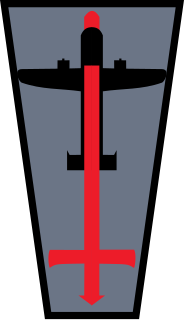The 303rd Infantry Brigade was a formation of the British Army organised from surplus Royal Artillery (RA) personnel retrained as infantry towards the end of the Second World War.
The 305th Infantry Brigade was a formation of the British Army organised from surplus Royal Artillery (RA) personnel retrained as infantry towards the end of the Second World War.
307th Infantry Brigade was a formation of the British Army organised from surplus Royal Artillery (RA) personnel retrained as infantry towards the end of the Second World War.
308th Infantry Brigade was a formation of the British Army organised from surplus Royal Artillery (RA) personnel retrained as infantry towards the end of the Second World War.

The 1st Anti-Aircraft Division was an Air Defence formation of the British Army before and during the early years of World War II. It defended London during the Battle of Britain and The Blitz.
27th Anti-Aircraft Brigade was an Air Defence formation of the British Army in World War II that served in The Blitz and later converted to infantry.

The 36th (Middlesex) Searchlight Regiment was a volunteer air defence battalion of Britain's Territorial Army (TA) from 1936 until 1961, at first as part of the Royal Engineers, later in the Royal Artillery. As part of 40th Anti-Aircraft Brigade it defended air bases in East Anglia through the Battle of Britain and the Blitz. Towards the end of 1944 the unit underwent infantry training, serving briefly in Norway at the end of the war. After the war, the 36th continued as a TA unit, with some women serving with it. In 1961, the remnants of the regiment amalgamated with others to form a combined infantry battalion, and all links with air defence were severed.
The 28th (Essex) Searchlight Regiment was a volunteer air defence unit of Britain's Territorial Army (TA) from 1935 until 1961, at first as part of the Royal Engineers, later in the Royal Artillery. During the Second World War it defended the approaches to London in The Blitz and Operation Diver before becoming a garrison unit in the liberation of Norway.
The 29th (Kent) Searchlight Regiment was a volunteer air defence unit of Britain's Territorial Army (TA) from 1935 until 1955, at first as part of the Royal Engineers (RE), later in the Royal Artillery (RA). It served during The Blitz, defended South West England, Orkney and Shetland before becoming garrison troops in North West Europe.
The 38th Light Anti-Aircraft Brigade was an air defence formation of Britain's Territorial Army formed just before World War II, which protected London and Southern England during the Blitz and later converted into an infantry formation for the liberation of Europe.
The 30th (Northumbrian) Anti-Aircraft Brigade was an air defence formation of Britain's Territorial Army from 1936 until 1955, which defended Tyneside and Sunderland during World War II.
The 31st Anti-Aircraft Brigade was an air defence formation of Britain's Territorial Army from 1936 until 1948. During World War II it defended West Yorkshire and later participated in the North West Europe campaign.
The 32nd (Midland) Anti-Aircraft Brigade was an air defence formation of Anti-Aircraft Command in Britain's Territorial Army (TA) from 1936 to 1955, charged with defending the East Midlands of England.
58th (Middlesex) Searchlight Regiment, Royal Artillery was an air defence unit of Britain's Territorial Army (TA) raised just before World War II. It defended the East Midlands of England during The Blitz, and later served as infantry in North West Europe at the end of the war, converting to the anti-aircraft (AA) artillery role postwar.
The 33rd (Western) Anti-Aircraft Brigade was an air defence formation of Anti-Aircraft Command of the Territorial Army, part of the British Army, formed shortly before the outbreak of World War II. It defended Merseyside and West Lancashire during The Blitz.

48th (Hampshire) Searchlight Regiment, Royal Artillery was an air defence unit of Britain's Territorial Army (TA) formed just before the outbreak of World War II from existing searchlight companies of the Royal Engineers. It served in Anti-Aircraft Command until 1944, including the Portsmouth Blitz and Operation Diver. At the end of the war it formed an infantry unit for garrison duties in liberated Europe. It continued in the postwar TA until AA Command was disbanded in 1955.

The 51st (Highland) Searchlight Regiment, Royal Artillery was a Scottish unit of Britain's Territorial Army (TA) formed for air defence just before World War II. It later served as an anti-aircraft (AA) artillery unit in the North West Europe Campaign 1944–45, and continued in the postwar TA into the 1950s.

The 59th (Warwickshire) Searchlight Regiment, Royal Artillery was an air defence unit of the Territorial Army (TA), part of the British Army, and was raised in Birmingham in 1938 just before the Second World War. It later served as a light anti-aircraft gun unit and continued in the postwar TA.
43rd Anti-Aircraft Brigade was an air defence formation of Britain's Territorial Army (TA). Formed in 1938, it was responsible for protecting Teesside in North East England during the early part of World War II, and later defended South East England from V-1 flying bombs. It was reformed postwar and survived under different titles until 1961.
68th Searchlight Regiment was a part-time air defence unit of Britain's Territorial Army converted from an infantry battalion just before World War II. It served in Anti-Aircraft Command defending the West of England until almost the end of the war, when it was converted back into an infantry battalion for occupation duties in North West Europe. Postwar it served on in the air defence role until the disbandment of AA Command in 1955.


